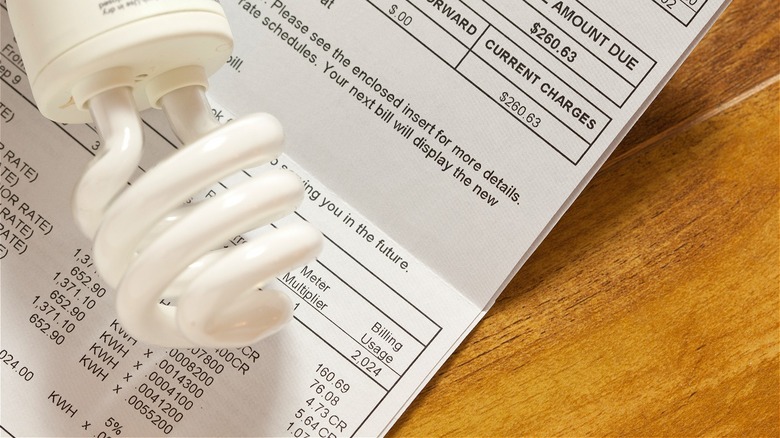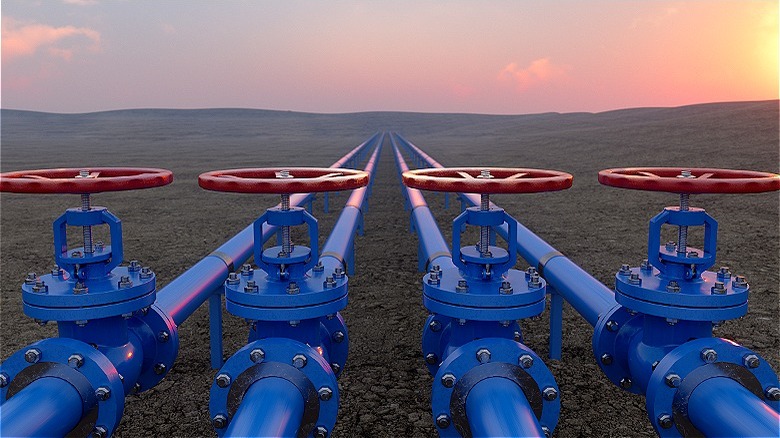What Is A Commodity Charge On Your Utility Bill?
Opening your utility bill each month can be a headache. According to the U.S. Energy Information Administration, electricity prices increased by 5% in 2022. Even worse, over the last 25 years, prices in the United States have increased by 2.36% annually — and these prices show no signs of slowing down. Per Bankrate, an average American household pays $6,888 in utility bills every year. What's more, it can be hard to know just what exactly you're paying for. You might have noticed a bevy of fees and listed costs on your monthly utility bills and wondered what all of them meant. While each utility can have its own associated fees (and vary depending on the state), almost all utilities include something called commodity charges.
To put it simply, commodities are the actual raw materials of your utilities, whether that be natural gas, electricity, or even water. It's important to realize that many of the utility companies you might be receiving service from don't actually produce their own electricity or natural gas. Many purchase their supply from specific producers instead and then pass that cost off to you as the consumer. The actual cost of the utility you're being billed for is the commodity charge, and this usually appears on your bill either by the volume, by therm, or even kWh, depending on the specific utility bill you're looking at. However, this all varies depending on the state you live in and what form of utility you are a customer of.
More on commodities and their prices
You may be surprised to learn there are a lot more commodities than just utilities. Since they're raw, natural ingredients necessary for other goods to be produced, they have a wide variety. Further, there are both hard and soft commodities. While hard commodities encompass things like oil, natural gas, and metals, soft commodities are generally more agricultural in nature like produce, livestock, cotton, and coffee. Since commodities are a kind of asset, their prices are ultimately determined by the law of supply and demand. For instance, during the winter when demand for heating oil and gas is high, prices will rise. Outside seasonal demands, economic changes and natural disasters can also impact demand. For example, during the COVID-19 pandemic, the drop in oil demand caused some to sell barrels for less than $0.
Commodities are popular on the stock market as they serve as a popular way to diversify investor portfolios. However, this investor interest can actually negatively affect the average consumer. Since commodity prices tend to rise during inflation, they can essentially hedge against inflation-created decreases in buying power. This means that investors tend to put even more focus on commodities during increases in inflation rates. This investor purchasing can and does further increase the prices of commodities, as well as the prices of all associated goods and services that subsequently rise to meet commodity pricing. This creates a cycle of increased prices that, while it serves investors, it hurts consumers.
Who decides how much to charge for commodities?
According to Bankrate, the most expensive utility for Americans is their cell phone service. It's estimated the average American household spends $1,844 per year on cell phone service, while the second most expensive is electricity at $1,644 per year. While commodity charges aren't responsible for that entire amount, they do play a part in overall utility prices. Generally speaking, the exact rate at which your utility company purchased the utility (i.e., natural gas, electricity) in the first place is the cost that's passed on to you as the consumer. However, not all utility companies see it that way, and some can and do include business operations costs in these fees. For instance, the cost to store and/or transport that utility can be factored into certain commodity charges.
Since the majority of American consumers receive their utilities from private companies (according to 2023 data from the American Public Power Association, 66.1% of U.S. customers receive services from privately owned utility companies), regulation is necessary. This regulation comes from state-level public service commissions. However, since these private companies tend to hold geographic monopolies that don't allow for competition, it still can be difficult to regulate prices for consumers. There are three types of utility companies: private (investor-owned), publicly owned (run by the state or federal government), and cooperative companies (not-for-profit). In 2021, public power utilities, which are a community-owned not-for-profit form of utilities, offered rates 12% lower than private utility companies.


